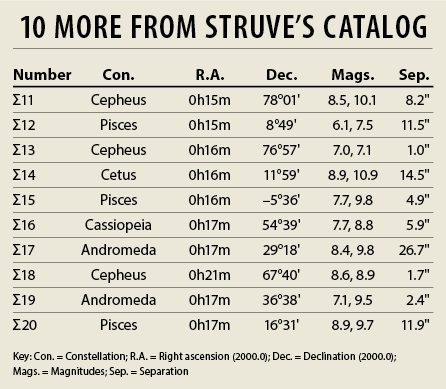I’ve been a double star fanatic since an August evening in 1963 when a high school friend showed me Mizar (Zeta [ζ] Ursae Majoris) with his 2.5-inch Gilbert reflector. During the 1970s, I hunted down double, triple, and multiple stars relentlessly, notching as many as I could through a 3-inch reflector. In all, I managed to split, then sketch and record in a logbook, nearly 1,500 pairs.
German-born Russian astronomer Wilhelm Struve cataloged most of these during a survey he conducted in the mid-1820s. I decided to copy the data for his entire catalog. I culled Struve pairs from a copy of the Lick Observatory Double Star Catalog and penciled it onto 5-by-8-inch lined file cards — 100 pairs for every three cards, or nearly 100 cards in all. Whew!
In my November 2014 column (“Struve’s stars”), I introduced this catalog and its first 10 entries. By popular demand, I’ve decided to continue with Struve (abbreviated Σ) 11 through 20. And although these stars have different declinations, they all lie within a 6-arcminute-wide band of right ascension. The data comes from the Washington Double Star Catalog (WDS).
Σ11
A relatively fixed pair, which means it’s shown little orbital motion (change in separation or position angle) since observations were made in Struve’s time. You’ll find it 1.5° east of Gamma (γ) Cephei.
Σ12
This is 35 Piscium, a beautiful little gem that is easily the pick of the litter here. It has shown only a slight decrease in separation since William Herschel measured it in 1782.
Σ13
This true binary pair has a period estimated to be around 1,600 years. The separation has increased by 0.5″ since Struve measured it in 1828. You’ll need a good 5-inch or larger scope, a magnification of 200x or more, and steady seeing conditions to notch this one!
Σ14
This relatively fixed double has a faint companion that will challenge small-aperture scopes.
Σ15
You’ll find this relatively fixed pair about 6.5° north and slightly west of Iota (ι) Ceti. Moderately high aperture and magnification is a must if you want to spot the magnitude 10 companion.
Here’s another duo that mandates an adequate-size scope and high magnification. This one is situated roughly midway between Sigma (σ) and Zeta Cassiopeiae.
Σ17
This is one of 21 pairs I observed with the 3-inch during a marathon morning session June 20, 1979. In my logbook I wrote, “Surrounded by an attractive sprinkling of faint stars.” The two have widened since Struve recorded a 20″ separation in 1828.
Σ18
Surprisingly, this duo doesn’t appear in the WDS with an “STF” designation. Instead, it’s listed with the John Herschel designation HJ 1018.
Σ19
You’ll find this pair in the same field as magnitude 4.5 Sigma Andromedae.
Σ20
This relatively fixed pair appeared rather faint when viewed through my 3-inch scope at 60x.
If you’re a dyed-in-the-wool double star fanatic, you may ask, “Will you be covering Struve 21–30 or, better yet, the entire catalog?” No can do, my friend! First of all, this column covers a variety of topics, and to devote it solely to double stars would rightfully enrage my readers who prefer other sights. Moreover, more than 3,100 multiple stars exist in the Struve catalog. At a 10-per-month pace, the entire job would encompass more than a quarter-century, and I may not be around that long.
However, you can put together your own Struve catalog, and you won’t need to spend months poring over the pages of the Lick catalog, suffering from writer’s cramp as you jot the info onto file cards. The Lick catalog was long ago supplanted by the WDS catalog, currently being maintained and continually updated by the U.S. Naval Observatory. If you observe double stars, you should consider it an essential resource.
Until then, you can access the catalog online at ad.usno.navy.mil, selecting “WDS” from the menu on the left. You’ll still need to be patient as you scroll down the pages looking for double stars with the STF designation. But then it’s a simple matter of using a word processor to cut and paste the relevant info. If doing the entire catalog seems a stretch, why not round up 21 through 30? According to my file card (now yellowed with age!), I’ve notched four of these with the 3-inch, and two are beauts! Which two? Find out for yourself.
Questions, comments, or suggestions? Email me at gchaple@hotmail.com. Next: A tour of the Washington Double Star Catalog. Clear skies!











